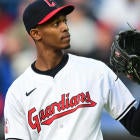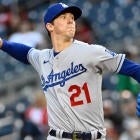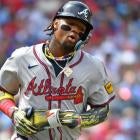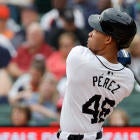The Angels stole the offseason headlines when they turned their Big Three of Jered Weaver, Dan Haren and Ervin Santana into an Even Bigger Four by signing C.J. Wilson (and also by signing that Pujols guy).
The former move is already paying dividends, as the Angels' rotation currently boasts a 3.37 ERA, the lowest in the American League. However, it's a minor league callup from last August that may have had the biggest impact on starting pitching in the junior circuit.
Fantasy owners have practically swooned over Brett Lawrie's potential for offensive production since his arrival in Toronto late last summer, but his presence in the Blue Jays' infield is helping owners who don't even have him on their roster. According to Fangraphs.com, Lawrie leads all major league third basemen in Ultimate Zone Rating, and he is well ahead of runner-up Mike Moustakas. He is just one part of a solid infield defense that has helped the Jays' rotation to a 3.53 ERA and a 1.20 WHIP, which rank second and third, respectively, in the American League. For comparison's sake, the Jays' starters posted a 4.55 ERA and a 1.36 WHIP just a year ago.
What is notable about the early achievements of Toronto's starters is that, as a unit, they have not been very good at striking out batters (5.8 K/9) or avoiding walks (3.2 BB/9). The key to their success is a collective ground ball rate in excess of 50 percent -- and what the infield has done with those frequent grounders. When opponents have put the ball on the ground against the Blue Jays, they have hit a major league-worst .156 this year. The Dodgers, who rank second, have held hitters to a .189 average on grounders, and the major league average is .226.
For those wondering how Ricky Romero, Brandon Morrow, Henderson Alvarez and Kyle Drabek can all have ERAs below 3.60, even though none has sparkling peripherals, this is how they are getting it done. Even though each has shown some flaws, Romero (3.9 BB/9) and Morrow (6.3 K/9, 1.5 HR/9) are still gaining the trust of Fantasy owners. Both are owned in more than 95 percent of the leagues on CBSSports.com and started in at least 88 percent of our leagues, so their past successes have apparently reassured owners that they are worth using.
However, neither Alvarez nor Drabek is owned in even 60 percent of our leagues and neither is starting in as many as one-third of our leagues. Alvarez currently ranks 38th in Head-to-Head points and 63rd in Rotisserie value, so essentially, he is worth starting in any standard mixed league format. When you start Alvarez, you're punting on strikeouts, as he has just 12 of them over his first six starts. Despite all of the contact, his WHIP is just 1.04, as he lets the infield do all the work. Alvarez has induced grounders on 57 percent of the balls hit off him, and the infield has converted 86 percent of those into outs. Drabek continues to be plagued by horrid command, and having issued more than a walk every other inning, his WHIP is a bloated 1.46. However, having allowed a .200 average on ground balls, only Drew Hutchison has allowed ground ball base hits at a higher rate among Toronto's current starters. On most teams, owners would be expecting Drabek's WHIP to regress upward, but as a Blue Jay, Drabek could actually see his WHIP decrease without any improvement in his walk rate.
Going back to 2003, no team has ever finished a season allowing opponents to bat below .200 on ground balls, so the Blue Jays' incredible start in this area looks at least a little fluky. General manager Alex Anthopoulos told CBSSports.com Senior Baseball Columnist Scott Miller, "I wouldn't put too much stock in (the low ground ball batting average). It's only five weeks into the season." On the other hand, Anthopoulos acknowledged, "We've done some shifts. We've got good infield defense." He singled out Yunel Escobar as a key contributor, saying, "His hands are unbelievable, and his range. It's a combination of things. Having a plus defensive shortstop helps. He's the captain of the infield." The metrics back up Anthopoulos' assessment, as Escobar ranks just behind defensive whiz Brendan Ryan as the AL's rangiest shortstop.
Because Alvarez allows so much contact, he will have to rely on his infield defense -- and probably some luck -- to maintain his standing in Fantasy. However, Alvarez possesses superb control, so between his strong ground ball tendencies and his low walk rate, he should be able to help owners with WHIP all season long. Drabek can't be counted on to help with WHIP, as owners shouldn't expect him to improve his control anytime soon. Anthopoulos noted that "sometimes it's hard for him to command the four-seamer because it has so much life," but because Drabek has been able to keep both his two-seamer and four-seamer down in the strike zone, he should be able to maintain the gains he has achieved in his ground ball rate, which now stands at 55 percent. That will enable him to strand runners at a high rate, so a sub-4.00 ERA is attainable.
The Blue Jays' pitchers are getting the most extreme bump from their infield defense to be sure, but there are other defenses that are giving their rotations some love with the glove. Here are four other teams who have been converting ground balls into outs at unusually high rates for at least some of their starters.
Nationals (.194 opponents' ground ball Avg.): Some owners may doubt the staying power of Gio Gonzalez's 0.90 WHIP, but it's supported by improved strikeout and walk rates and a .167 opponents' batting average on grounders. Some regression is to be expected, but given the quality of the Nats' infield defense and Gonzalez's greatly improved strike-throwing ability, he may no longer be just an average pitcher for WHIP. If you're a Gonzalez owner, resist the impulse to sell him at what might look like peak value. Jordan Zimmermann (.182 opponents' ground ball Avg.) didn't really need WHIP help, but this is just one more factor that makes him far more valuable than his 61 percent activation rate would indicate.
Mariners (.205 opponents' ground ball Avg.): With the aforementioned Ryan anchoring their infield, the Mariners' starters should stand to gain from the potential for ground ball outs. However, Felix Hernandez doesn't allow a lot of balls in play, and Hector Noesi and Blake Beavan have been generating more flyballs than grounders. That leaves Jason Vargas (.153) and Kevin Millwood (.269) as the most likely candidates to benefit from the team's solid defense, particularly on the left side of the infield. Millwood's command has been so poor that he won't be worth using in most leagues, even if he starts getting more ground ball outs, but Vargas' 1.03 WHIP may not be as much of an outlier as it appears to be.
Diamondbacks (.215 opponents' ground ball Avg.): The Diamondbacks' opponents' ground ball batting average is just a little below the major league norm, but given how well Aaron Hill and Willie Bloomquist have performed in the field, it's a rate that is sustainable. Trevor Cahill (.189) and Wade Miley (.136) have both been reliable ground ball producers, and a high rate of ground outs has helped both to low WHIPs despite mediocre walk rates. Miley is the stronger candidate to regress, but he and Cahill both can continue to have success, even though neither has a history of strong command. With an unusually-low 1.13 WHIP, you would think Joe Saunders would be getting some help from his "D," but that hasn't been the case. Batters are hitting .237 against him on grounders, but while that rate should drop, that doesn't mean that Saunders is due for better times ahead. He is not a good bet to maintain a 16 percent line drive rate, so ultimately, the numbers you're getting from Saunders now represent his upside.
Rays (.232 opponents' ground ball Avg.): Despite an infield defense that has not performed well, at least according to UZR, the Rays have been close to average in opponents' ground ball batting average. The team's frequent use of the shift is likely to have something to do with that, and Jeremy Hellickson (.180) and Jeff Niemann (.184) have been the biggest apparent beneficiaries so far. Matt Moore's .333 mark is bound to shrink, but he has been allowing so many flyballs as to render his infield defense almost irrelevant. Even with the Rays deploying the shift on a regular basis, Hellickson and Niemann will likely give up ground ball base hits at a higher rate going forward, but they may not be the BABIP liabilities that you would expect, given their infield's defensive woes.
|
|
|
xFIP: Also known as Expected Fielding Independent Pitching.
It is an estimate of what a pitcher's ERA would be if it were
based on factors that a pitcher can control, such as strikeouts,
walks and flyballs. xFIP is a derivative of FIP, which was
developed by Tom Tango. Runs Created per 27 Outs (RC/27) -- An estimate of how many runs a lineup would produce per 27 outs if a particular player occupied each spot in the order; ex. the RC/27 for Miguel Cabrera would predict the productivity of a lineup where Cabrera (or his statistical equal) batted in all nine spots; created by Bill James Component ERA (ERC) -- An estimate of a what a pitcher's ERA would be if it were based solely on actual pitching performance; created by Bill James GO/AO -- Ground out-air out ratio GB/FB -- Ground ball-fly ball ratio Batting Average per Balls in Play (BABIP) -- The percentage of balls in play (at bats minus strikeouts and home runs) that are base hits; research by Voros McCracken and others has established that this rate is largely random and has a norm of approximately 30% Isolated Power -- The difference between slugging percentage and batting average; created by Branch Rickey and Allan Roth Walk Rate -- Walks / (at bats + walks) Whiff Rate -- Strikeouts / at bats |
Stay in touch with the most passionate Fantasy staff in the business by following us on Twitter @CBSFantasyBB or Al Melchior at @almelccbs . You can also e-mail us at fantasybaseball@cbsinteractive.com .





















